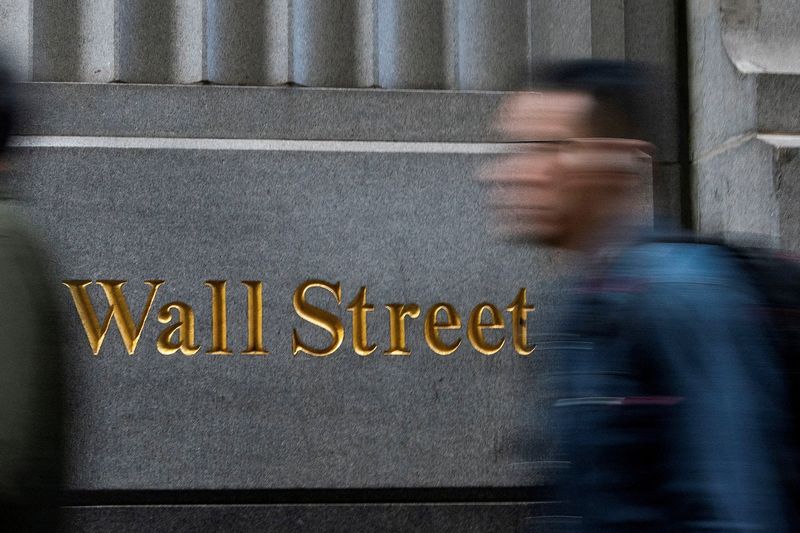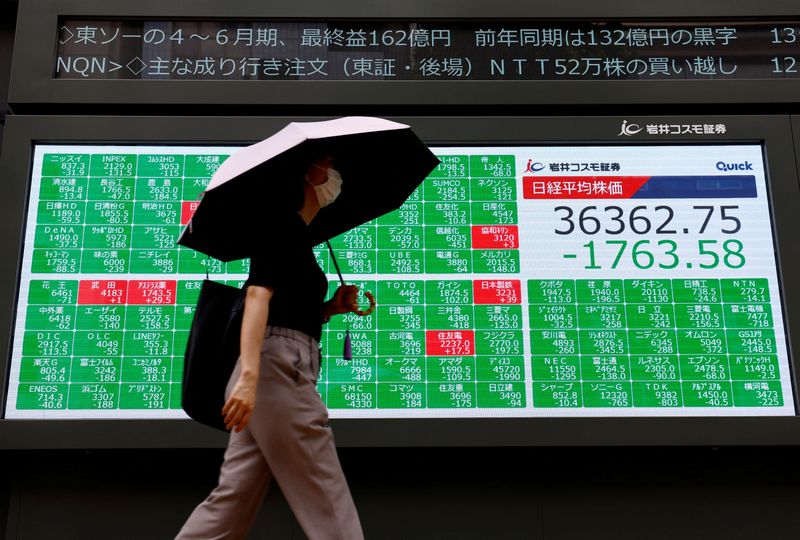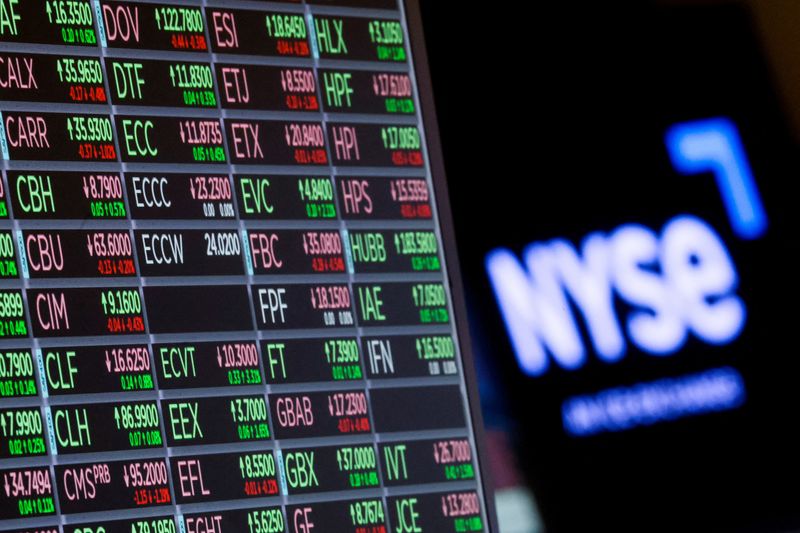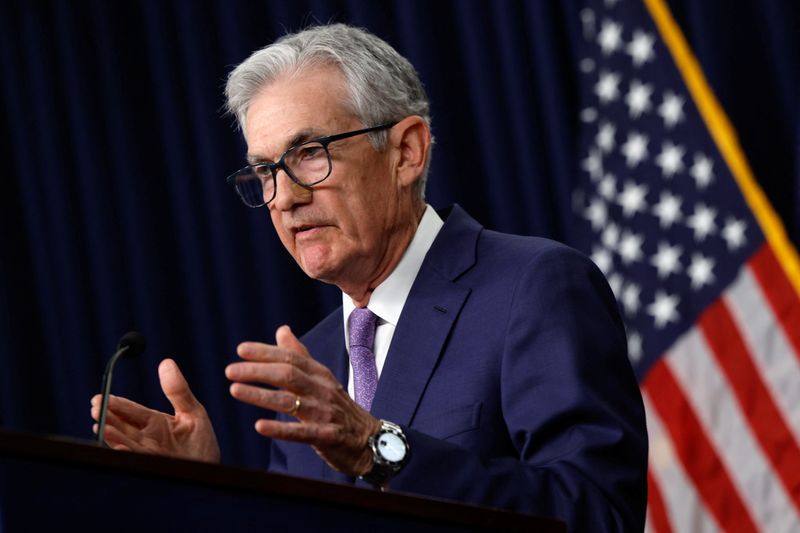Select Language

By Lewis (JO:LEWJ) Krauskopf
NEW YORK (Reuters) -Investors are expecting more gains for the U.S. stock market in 2025 after two straight standout years, fueled by a solid economy supporting corporate profits, moderating interest rates and pro-growth policies from incoming President Donald Trump.
The benchmark S&P 500 was up 23.31% in 2024, even with a recent speed bump, marking its second-straight year of gains exceeding 20%, lifted by megacap tech stocks and excitement over the business potential of artificial intelligence.
The index soared 53.19% over the last two years, the biggest two-year percentage jump since 1998.
Investors are more confident about the economy than this time a year ago, with consumers and businesses having absorbed higher interest rates and the Federal Reserve now lowering them - albeit by not as much as hoped. Corporate profits are also expected to be strong, with S&P 500 earnings per share projected to rise 10.67% in 2025, according to LSEG.
On the other side of the ledger, inflation remains stubborn, and Wall Street is wary of a rebound that could lead the Fed to change course on its easing cycle. Indeed, stocks pulled back sharply earlier in December after the central bank projected fewer rate cuts next year as it braced for firmer inflation.
Such prospects could become more likely if Trump implements tariffs on U.S. imports that lead to higher consumer prices. Stock valuations, meanwhile, are around their steepest levels in more than three years, leaving greater potential for turbulence.
"We've been on quite the tear coming off the lows back at the end of 2022. It's been pretty eye-watering," said Garrett Melson, portfolio strategist at Natixis Investment Managers.
"Animal spirits ... are certainly running pretty wild right now, but you might need to temper that a little bit as you start to move through the year," said Melson, who thinks the stock market could still produce solid gains of around 10% in 2025 if not the returns of the prior two years.
Wall Street firms are mostly projecting gains for the market next year, with S&P 500 year-end targets ranging from 6,000 to 7,000 points. The index ended 2024 at 5,881 on Tuesday.
Optimistic investors can point to a bull market that is neither old nor over-extended by historic measures.
The current bull market for the S&P 500 that began in October 2022 is less than half as long as the average length of the 10 prior ones, according to Keith Lerner, co-chief investment officer at Truist Advisory Services. The S&P 500's roughly 64% gain during this latest run trails the 108% median gain and 184% average rise of the prior bull markets, according to Lerner.
"If you zoom out a little bit, yes, we have a lot of gains, but if you look at a typical bull market, it suggests that we still have further gains to go," Lerner said.
Other historic signs also bode well. The S&P 500 has gained an average of 12.3% following the eight instances of back-to-back 20% annual gains since 1950, according to Ryan Detrick, chief market strategist at Carson Group, compared to a 9.3% overall average increase over that time. The index increased six of the eight times.
ECONOMY WEATHERING RATES
Bolstering the upbeat sentiment is the prevailing sense on Wall Street that the economy has weathered the rate hikes the Fed implemented starting in 2022 to quell inflation.
A Natixis Investment Managers survey conducted in recent weeks found 73% of institutional investors said the U.S. will avoid a recession in 2025. That is a sharp turnaround from a year ago, when 62% projected such a downturn in the coming year.
Citigroup (NYSE:C)'s economic surprise index, which measures how economic data performs versus expectations, has been solidly positive for the past two months, another rosy sign for investors.
Adding to expectations of a solid economy, Trump is expected to pursue an agenda that includes tax cuts and deregulation that supports growth.
"We're leaving 2024 on pretty good footing, and we think there is some re-acceleration in 2025," said Sameer Samana, senior global market strategist at Wells Fargo (NYSE:WFC) Investment Institute. "Markets tend to front-run the economy, so they will position for that economic re-acceleration sooner rather than later."
However, stocks are also leaving 2024 at elevated valuations: the S&P 500 was trading at 24.82 times expected earnings over the next 12 months, according to LSEG. That is well above its long-term average of 15.8, and not far from the 22.6 level it reached earlier this month, its highest since early 2021.
Investors maintain that valuations can stay high for long periods and do not necessarily indicate imminent declines. But future gains may rest more on earnings growth, while higher valuations could make stocks more easily rattled by any disappointments.

By Naveen Thukral and Florence Tan
SINGAPORE (Reuters) - Cocoa and coffee are poised to close 2024 as the biggest gainers among commodities for a second year on a global supply deficit, while steel-making coal will end as the worst performer, hit by slow growth in China.
Looking ahead, global trade tensions are likely to dominate the commodities landscape in 2025 as Donald Trump returns to the White House threatening hefty tariffs, analysts said.
A strong dollar and gold's appeal as a safe haven for investors are likely to support precious metals prices, while ample supply could depress oil for a third year, they added.
In bad news for chocolate lovers, cocoa nearly tripled in price over 2024, far outpacing gains in other commodities. It hit a record high of $12,931 a metric ton in New York earlier this month on forecasts of lower supply for a fourth successive season in West Africa following dry weather.
"The softs sector, led by cocoa and coffee, has been the main winner amid adverse weather in key growing regions, highlighting the risk to prices when products like these are produced and sourced from relatively small geographical areas," said Ole Hansen, head of commodity strategy at Saxo Bank in Copenhagen.
Top cocoa producers Ivory Coast and Ghana have suffered crop losses due to adverse weather, bean disease, smuggling and reduced plantations in favour of illegal gold mining.
Dryness has strained coffee supplies as well. ICE Arabica coffee prices soared to their highest in more than 40 years amid fears that severe drought earlier this year damaged the upcoming crop in top producer Brazil.
CHINA GROWTH WORRIES HIT OIL, IRON ORE
Crude oil and bulk metals faced headwinds in 2024 as China, the world's second-biggest economy and top commodities buyer, struggled mainly due to a property crisis.
Brent and West Texas Intermediate crude could post a third consecutive annual decline in 2025 as supply outstrips a rebound in demand growth, analysts said, although Trump's policies on major producers Russia and Iran could curb supply.
Spare capacity in the Organization of the Petroleum Exporting Countries (OPEC) reached an unprecedented 5 million barrels per day (bpd), analysts estimated, with the group having extended production cuts to March.
"The bleak inventory path next year suggests that OPEC+ will be challenged to bring back barrels into the market," Harry Tchilinguirian, head of research at Onyx Capital Group, said in a note.
Iron ore prices in China recouped some losses in recent months but are still headed for a 15% decline in 2024. Prices could fall again next year as iron ore supply grows and Chinese steel demand falls, analysts said, despite Beijing's stimulus measures.
"We expect the increase in iron ore supply from major miners will be higher than that in 2024, but steel output in China will likely slide," Pei Hao, senior analyst at brokerage Freight Investor Services, said, forecasting an average price of $100 a ton in 2025, down from an average of $110 in 2024.
Gold and silver rose more than 25% in 2024 and could climb further in the year ahead depending on the U.S. Federal Reserve's interest rate cuts and Trump's tariff, tax and foreign policies, analysts said.
"Gold is the standout for us in 2025," ING's head of commodity research Warren Patterson said, adding that strong gold purchases by central banks will support demand.
Copper and aluminium prices are set to end 2024 higher, driven by tight supplies, the energy transition and hopes that China's stimulus measures will boost demand.
PALM OIL, RUBBER AND GRAINS
For agricultural products, Malaysian palm oil futures jumped around 20% in 2024, snapping two consecutive years of losses, lifted by Indonesia's biodiesel mandate and adverse weather in Indonesia and Malaysia.
Crop-threatening weather also drove a 42% gain in Tokyo rubber futures.
In contrast, soybeans, corn and wheat were in plentiful supply, all on track for losses in 2024. However, wheat prices could find some support in 2025 as warmer weather in Russia, the biggest exporter, threatens to reduce output.
Top soybean exporter Brazil is poised to deliver record supplies in 2025, positioning it to meet a rise in Chinese demand if a Washington-Beijing trade war erupts.

By Ankur Banerjee
SINGAPORE (Reuters) - Asian stocks eased on Tuesday in cautious end-of-year trading that has seen investors scale back bets of deep U.S. rate cuts in 2025 and brace for the incoming Trump administration, with the dollar standing tall against most other currencies.
Volumes were light with a holiday for the New Year looming and Japan on holiday for the rest of the week, with the Santa-rally losing some steam as elevated Treasury yields weigh on high equity valuations and boost the greenback.
MSCI's broadest index of Asia-Pacific shares outside Japan nudged down 0.2% but was set for an 8% gain in 2024, its second straight year in the black.
China's blue-chip CSI300 index was flat while Hong Kong's Hang Seng index was 0.3% higher in early trading.
Data earlier in the day showed China's manufacturing activity expanded for a third straight month in December but at a slower pace, suggesting a blitz of fresh stimulus is helping to support the world's second-largest economy.
On Wall Street, all three major U.S. indexes closed on Monday with sharp losses in a broad selloff at the end of a strong year mainly due to end-of-year tax positioning, valuations worries and uncertainties about 2025.
Kyle Rodda, senior financial market analyst at Capital.com., said the principle issue for the markets right now is the risk of a "re-rating in bond markets, due to persistent inflation in the U.S. and the impacts of Trump tax-cuts and tariffs."
Despite the year-end weakness, U.S. stocks have surged this year, with the Nasdaq on track for about a 30% annual gain and the S&P 500SPX> headed for more than a 24% rise.

By Rahul Paswan
(Reuters) - Gold prices were little changed on Tuesday, the last trading day of an eventful year that saw the metal post its best annual performance in more than a decade.
Spot gold rose 0.1% at $2,608.09 per ounce, as of 0217 GMT. U.S. gold futures gained 0.1% to $2,620.60.
Trading activity is expected to remain quiet on the last day of the year.
"Gold enjoyed a stellar year in 2024 and much of that move higher was predicated on the expected transition towards a lower interest rate environment," said Tim Waterer, chief market analyst at KCM Trade.
Central bank buying, policy easing and geopolitical tensions propelled bullion to multiple record highs this year, setting the metal on track for its best performance since 2010, with a more than 26% increase year-to-date.
The market now awaits a fresh set of catalysts, including a slew of U.S. economic data due next week that could influence the interest rate outlook for 2025, and President-elect Donald Trump's tariff policies.
For 2025, "the U.S. interest rate outlook will remain a primary driver of the gold price. Trump's trade policies will be key in shaping the inflationary picture, the Fed's interest rate trajectory, and in turn, the gold price," Waterer said.
Federal Reserve's policymakers this month cut their 2025 rate forecast to 50 basis points of cuts from 100 bps and Fed Chair Jerome Powell said more reductions now hinge on further progress in lowering inflation.
Bullion is considered a hedge against inflation and turmoil but high rates reduce the non-yielding asset's appeal.
"Going into 2025, I think the trend is bullish and fundamentals constructive for gold, which I believe ought to challenge record highs again," said Kyle Rodda, financial market analyst at Capital.com.
Spot silver steadied at $28.98 per ounce and palladium added 0.5% to $908.25, while platinum was flat at $900.71.
Silver was headed for its best year since 2020, while platinum and palladium were set for annual losses.

U.S. stock index futures edged lower on Monday evening after Wall Street fell sharply amid profit-taking at the end of a strong year.
S&P 500 Futures inched 0.2% lower to 5,946.25 points, while Nasdaq 100 Futures fell 0.2% to 21,374.75 points by 18:34 ET (23:34 GMT). Dow Jones Futures were largely steady at 42,911.0 points.
Tech stocks fall amid year-end trading, higher treasury yields
Investors capitalized on substantial gains accumulated throughout the year, particularly in the technology sector.
Concurrently, rising treasury yields exerted additional pressure on equities. Higher yields make bonds more attractive to investors seeking lower-risk returns, potentially drawing capital away from stocks.
Among “Magnificent Seven” megacaps, Apple Inc (NASDAQ:AAPL) and Microsoft Corporation (NASDAQ:MSFT) declined 1.3% each, while Meta Platforms Inc (NASDAQ:META) and Amazon.com Inc (NASDAQ:AMZN) also fell.
NVIDIA Corporation (NASDAQ:NVDA) inched up 0.4%, while Tesla Inc (NASDAQ:TSLA) fell more than 3%.
Bank of America called the megacap stocks “expensive and crowded” in a recent note, while it preferred mid-cap equities for better opportunities in 2025.
Boeing slumps after South Korea crash
Boeing Co (NYSE:BA) shares fell more than 2% after a devastating air accident in South Korea claimed the lives of 179 people on Sunday when a passenger plane crash-landed at Muan International Airport.
The aircraft, a Boeing 737-800, skidded off the runway, colliding with a wall and erupting in flames, making it the deadliest aviation disaster in the country’s history.
Wall Street set for stellar yearly gains
On Monday, the S&P 500 fell 1.1% to 5,906.94 points, the Dow Jones Industrial Average lost 1% to 42,573.73, while the NASDAQ Composite declined 1.2% to 19,486.79 points.
Despite recent losses, 2024 has been a remarkable year for U.S. equities, with all major indexes nearing record highs.
The Nasdaq is on track for a roughly 30% annual gain, while the S&P 500 is set to rise over 24%, and the Dow has climbed more than 13%, marking the best performance for these averages since 2021.
Later in the week, investors will scrutinize the Institute of Supply Management's manufacturing activity survey for December and a weekly report on jobless claims, ahead of a key employment report due in the following week.

(Reuters) - Contracts to buy U.S. previously owned homes rose more than expected in November, notching a fourth straight month of gains as buyers focused on taking advantage of improved inventory despite stubbornly high mortgage rates.
The National Association of Realtors (NAR) said on Monday its Pending Home Sales Index, based on signed contracts, rose 2.2% last month to 79.0 - the highest since February 2023 - from 77.3 in October. Economists polled by Reuters had forecast contracts, which become sales after a month or two, would rise 0.9% after increasing 1.8% in October.
Pending home sales rose 6.9% from a year earlier. On a regional basis, the Midwest, South and West saw monthly increases while contract signings slipped in the Northeast. All four regions posted annual gains.
The increase in contract signings in November dovetailed with a second straight rise in existing home purchase completions last month reported previously by NAR. That earlier report showed the inventory of homes for sale in November was up by nearly 18% from a year earlier.
"Consumers appeared to have recalibrated expectations regarding mortgage rates and are taking advantage of more available inventory," said Lawrence Yun, the NAR's chief economist. "Mortgage rates have averaged above 6% for the past 24 months. Buyers are no longer waiting for or expecting mortgage rates to fall substantially. Furthermore, buyers are in a better position to negotiate as the market shifts away from a seller’s market."
Indeed, the rate on popular 30-year-fixed-rate mortgages has climbed in the past two months to the highest since July at 6.85%, according to Freddie Mac (OTC:FMCC), essentially counter-acting the interest rate cuts delivered since September by the Federal Reserve.
The 10-year U.S. Treasury note, which is the top influence in determining rates on most home loans, has climbed by roughly a percentage point since September. That has occurred as bond market investors have grown concerned about how policies favored by President-elect Donald Trump - such as tariffs, tax cuts and immigration crackdowns - might feed into higher inflation.

Investing.com -- Federal Reserve Chair Jerome Powell is navigating familiar territory as he heads into 2025, aiming to balance the central bank’s independence while avoiding confrontation with Donald Trump.
Powell’s challenge lies in managing monetary policy without appearing to preemptively counter potential inflationary pressures from the incoming administration’s policies.
The balancing act has been evident in recent months. Shortly after Trump’s election victory in November, Powell emphasized that the Fed wouldn’t speculate on how future policies might influence interest rates.
“We don’t guess, we don’t speculate, and we don’t assume,” Powell said on Nov. 7. However, the Fed’s latest projections suggest some officials are already accounting for policy changes, signaling fewer rate cuts in 2025 due to inflation concerns.
Last week, the Fed cut rates by a quarter point, completing a full percentage point reduction since September. Despite this, updated forecasts revealed a more cautious stance on easing.
Most officials now anticipate only two cuts next year, down from four projected in September. Inflation is expected to remain at 2.5% in 2025, up from earlier forecasts of 2.2%. Notably, 15 of 19 Fed officials see a risk that inflation could exceed projections.
Michael Gapen, chief U.S. economist at Morgan Stanley (NYSE:MS), noted the shift. The latest meeting “came out much more hawkish than we thought because they did what they said they weren’t going to do: They said they weren’t going to speculate on policies and then a month later they decided to speculate on policies,” he said.
A key factor behind this caution is Trump’s proposed economic agenda, which includes tariffs and stricter immigration policies. Tariffs could drive prices higher, while tighter border controls might constrain labor supply, increasing wages. Powell has downplayed the direct impact of Trump’s election on inflation forecasts, attributing the shift to recent inflation data instead.
Despite this, Powell has, according to the Wall Street Journal, privately advised colleagues to tread carefully in public remarks to avoid perceptions of political bias. This approach aligns with Powell’s efforts to maintain the Fed’s reputation for apolitical, data-driven decision-making.
The stakes are high. Powell recalls the Fed’s experience during Trump’s first term when trade wars led to rate cuts. Yet the current environment differs. Inflation has been elevated, unlike the low-inflation backdrop of 2018. Powell highlighted this distinction at his Dec. 18 press conference, referencing past internal Fed analyses.
“What the committee’s doing now is discussing pathways and understanding again the ways in which tariffs can affect inflation and the economy,” said Powell. “It puts us in position, when we finally do see what the actual policies are, to make a more careful, thoughtful assessment of what might be the appropriate policy response.”
Trump’s advisors argue that deregulation and increased energy production could offset inflationary risks. Treasury secretary-designate Scott Bessent downplayed concerns.
“Tariffs can’t be inflationary because if the price of one thing goes up, unless you give people more money, then they have less money to spend on the other thing, so there is no inflation,” he said on a radio program hosted by Larry Kudlow, a former Trump adviser.
Still, analysts believe the Fed will respond cautiously if supply-side improvements reverse.
“In this environment, you’re not coming from six years of below-target inflation. You’re coming from a few years of being well above target,” notes JPMorgan’s chief economist Michael Feroli.
Other analysts suggest that the economic environment will significantly influence how much businesses pass rising costs to consumers.
Economist Ray Farris believes that with full employment, cost increases are more likely to be passed through than during a downturn. He also highlights the uncertainty around how quickly companies adjust prices, explaining that gradual increases could make inflation appear more persistent to the public.

MANILA (Reuters) - Philippine President Ferdinand Marcos Jr. signed the 2025 budget into law on Monday, saying a planned 10% increase in government spending to a record 6.33 trillion pesos ($109.2 billion) would support economic growth and reduce poverty.
The spending is higher than a projection of 6.18 trillion pesos announced earlier this month, when revenue was forecast at 4.64 trillion pesos and the budget deficit at 5.3% of GDP."It is designed not just to address our present need but to sustain growth and to uplift the lives of generations that are yet to come," Marcos said following the ceremonial signing.The education sector has the largest budget allocation for 2025 with 1.053 trillion pesos, followed by the public works ministry at 1.034 trillion, Budget minister Amenah Pangandaman said in a press briefing.
Pangandaman said 35 billion pesos were earmarked for the military's modernisation programme, lower than the 50 billion pesos that government originally proposed.
Budget advocates have complained about reductions in the education budget and the removal of a subsidy for the government health insurance programme, among other cuts.
Marcos had delayed the signing by more than a week, citing the need to review the final spending plan approved by Congress. He said he had vetoed proposed spending of more than 194 billion pesos ($3.35 billion).
Government spending historically contributes around a fifth of the country's economic growth, which is targeted at 6.0% to 8.0% in 2025.
($1 = 57.908 Philippine pesos)

TOKYO (Reuters) - Japan's factory activity shrank at a slower pace in December as declines in production and new orders eased, a private-sector survey showed on Monday, edging closer to stabilisation after recent falls.
The final au Jibun Bank Japan manufacturing purchasing managers' index (PMI) rose to 49.6 in December, indicating the softest contraction in three months. The index was slightly higher than 49.5 in the flash reading and 49.0 in November but stayed below the 50.0 threshold that separates growth from contraction for the sixth straight month.
"The headline reading moved closer to neutrality amid softer reductions in both production and new order intakes," said Usamah Bhatti at S&P Global Market Intelligence, which compiled the survey.
The subindex of production shrank for a fourth straight month in December but the contraction was also slower than last month. Manufacturers noted that subdued new orders were the main factor behind the decline in output.
New orders contracted for the 19th straight month on subdued demand in both domestic and key overseas markets. Some firms in the survey suggested the semiconductor market was behind the weakness in new orders.
Employment expanded in December, reversing its fall in November, to reach its highest level since April. Firms in the survey said they hired more workers due to labour shortages as well as in preparation for future demand.
Input prices grew at the strongest pace since August, with firms citing higher costs of raw materials and labour. The weak yen also boosted inflation. To cope with rising prices, firms raised their output prices at the fastest rate in five months.
Manufacturers stayed confident about their outlook as they expect business to expand thanks to the launch and mass production of new products.

By Wayne Cole
SYDNEY (Reuters) - Asian shares edged lower on Monday as high Treasury yields challenged lofty Wall Street equity valuations while underpinning the U.S. dollar near multi-month peaks.
Volumes were light with the New Year holiday looming and a rather bare data diary this week. China has the PMI factory surveys out on Tuesday, while the U.S. ISM survey for December is due on Friday.
MSCI's broadest index of Asia-Pacific shares outside Japan dipped 0.2%, but is still 16% higher for the year. Japan's Nikkei eased 0.2%, but is sitting on gains of 20% for 2024.
South Korea's main index has not been so fortunate, having run into a storm of political uncertainty in recent weeks, and is saddled with losses of more than 9% for the year. It was last off 0.35%.
S&P 500 futures and Nasdaq futures were both off 0.1%. Wall Street suffered a broad-based sell off on Friday with no obvious trigger, though volumes were just two-thirds of the daily average. .[.N]
The S&P 500 is still up 25% for the year and the Nasdaq 31%, which is stretching valuations when compared to the risk-free return of Treasuries. Investors are counting on earnings per share growth of just over 10% in 2025, versus a 12.47% expected rise in 2024, according to LSEG data.
Yet yields on 10-year Treasuries are near eight-month highs at 4.631% and ending the year around 75 basis points above where they started it, even though the Fed delivered 100 basis points of cuts to cash rates.
"The continued rise in bond yields, driven by the reassessment of less restrictive monetary policy expectations, creates some concern," said Quasar Elizundia, a research strategist at broker Pepperstone.
"The possibility that the Fed may keep restrictive monetary policy for longer than expected could temper corporate earnings growth expectations for 2025, which could in turn influence investment decisions."
Bond investors may also be wary of burgeoning supply as President-elect Donald Trump is promising tax cuts with few concrete proposals for restraining the budget deficit.
Trump is expected to release at least 25 executive orders when he takes office on Jan. 20, covering a range of issues from immigration to energy and crypto policy.
Widening interest rate differentials have kept the U.S. dollar in demand, giving it gains of 6.5% for the year on a basket of major currencies.
The euro has lost more than 5% on the dollar so far in 2024 to last stand at $1.0429, not far from its recent two-year trough of $1.0344.
The dollar held near a five-month top on the yen at 157.71, with only the risk of Japanese intervention preventing another test of the 160.00 barrier.
The strength of the dollar has been something of a burden for gold prices, though the metal is still 28% higher for the year so far at $2,624 an ounce. [GOL/]
Oil has had a tougher year as concerns about demand, particularly from China, kept a lid on prices and forced OPEC+ to repeatedly extend a deal to limit supplies. [O/R]
Brent fell 37 cents to $73.80 a barrel, while U.S. crude lost 17 cents to $70.43 per barrel.

